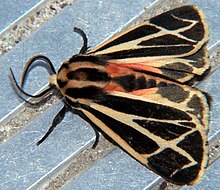Arctiinae (erebid moths)
| Arctiinae | |
|---|---|
 |
|
| Harnessed tiger moth Apantesis phalerata |
|
| Scientific classification | |
| Kingdom: | Animalia |
| Clade: | Euarthropoda |
| Class: | Insecta |
| Order: | Lepidoptera |
| Superfamily: | Noctuoidea |
| Family: | Erebidae |
| Subfamily: |
Arctiinae (Leach, 1815) |
| Type species | |
|
Arctia caja (Linnaeus, 1758) |
|
| Diversity | |
| 1,400–1,500 genera Approximately 11,000 species |
|
The Arctiinae (formerly called the Arctiidae) are a large and diverse subfamily of moths, with around 11,000 species found all over the world, including 6,000 neotropical species. This group includes the groups commonly known as tiger moths (or tigers), which usually have bright colours, footmen, which are usually much drabber, lichen moths, and wasp moths. Many species have "hairy" caterpillars that are popularly known as woolly bears or woolly worms. The scientific name of this subfamily refers to this hairiness (Gk. αρκτος = a bear). Caterpillars may also go by the name "tussock moths" (more usually, however, this refers to the Lymantriidae).
The subfamily was previously classified as the Arctiidae family of the Noctuoidea superfamily and is a monophyletic group. Recent phylogenetic studies have shown that the group is most closely related to litter moths Herminiinae and the Old World Aganainae, which are subfamilies of the Erebidae family. The Arctiidae as a whole have been reclassified to represent this relationship. The family was lowered to subfamily status as the Arctiinae within the Erebidae. The subfamilies and tribes of Arctiidae were lowered to tribes and subtribes, respectively, of this new Arctiinae to preserve the internal structure of the group.
Many genera are classified into the following tribes, while others remain unclassified (Incertae sedis).
The most distinctive feature of the subfamily is a tymbal organ on the metathorax. This organ has membranes which are vibrated to produce ultrasonic sounds. They also have thoracic tympanal organs for hearing, a trait which has a fairly broad distribution in the Lepidoptera, but the location and structure is distinctive to the subfamily. Other distinctive traits are particular setae ('hairs') on the larvae, wing venation, and a pair of glands near the ovipositor. The sounds are used in mating and for defense against predators. Another good distinguishing character of the subfamily is presence of anal glands in females.
...
Wikipedia
